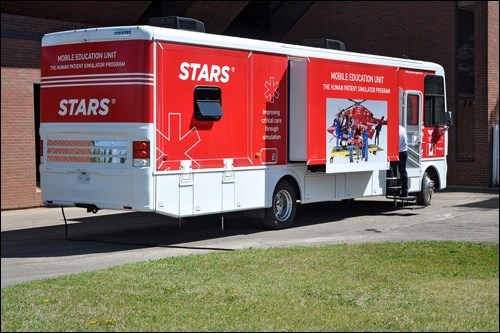North Battleford was the latest stop for a human patient simulator used to train physicians, nurses and other health care professionals in their duties.
The Mobile Education Program, part of STARS Air Ambulance, was at Battlefords Union Hospital May 20. Four teams of physicians and nurses trained inside the facility, which is basically a motorhome fitted up as an emergency room.
It features a human patient simulator called iSTAN, who not only has the ability to breathe and bleed but can also speak and respond in a manner similar to real patients facing an emergency situation.
Health care personnel can check the mannequin’s pulse, check for breathing, check for vital signs and perform what is required to stabilize the patient. There is a computer and also four monitors that can monitor heart rate and other vital signs.
The mobile education program has been up and running since last year. North Battleford is one of 30 communities the program has been to, and more than 500 health practitioners have participated.
The mobile unit itself is fully funded through STARS own fundraising efforts across the province. STARS provides air ambulance service from two bases in Saskatchewan.
The opportunity to gain state-of-the-art training on how to react in an emergency situation is welcomed by hospital officials and staff.
“Emergency medicine and nursing is changing all the time, and so to keep up on the new, latest based evidence is sometimes difficult for rural hospitals,” said Chris Etcheverry, nurse manager for the emergency room at BUH.
“We’re really fortunate to have STARS come at no charge to the hospital to provide some of this education for our staff, our physicians, our RTs and nurses as well.”
Staff were enthusiastic about signing up for the training and all the training spots were filled within 24 hours.
“People were really receptive to us coming out,” said Matthew Hogan, flight paramedic and mobile education leader with STARS.
The plan was for each group to go through two simulations of critically ill or injured — similar to what they would experience in their own emergency room.
Having a mannequin there “gives them the opportunity to practise these critical cases in a safe learning environment.”
As well, compared to other mannequins that are not at the same level of technology, “this is more realistic for the learner,” said Hogan.
“The real goal here is to get the opportunity to practice on these very sick patients.”




